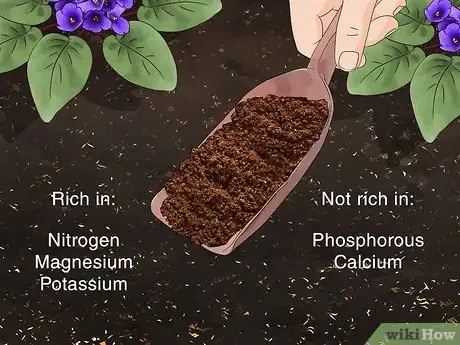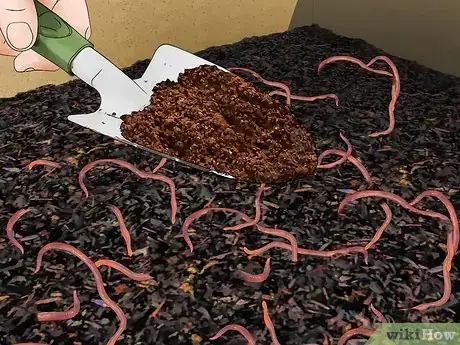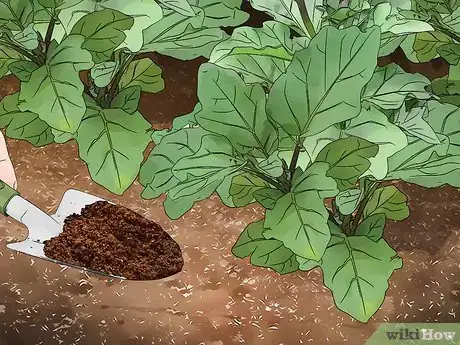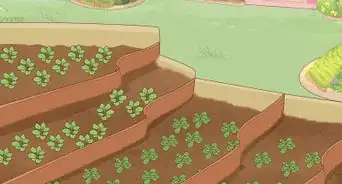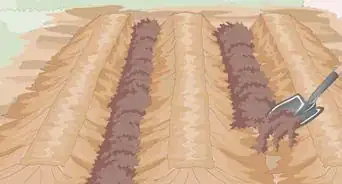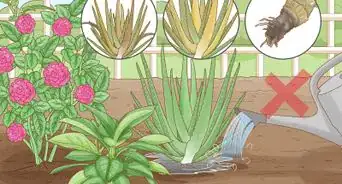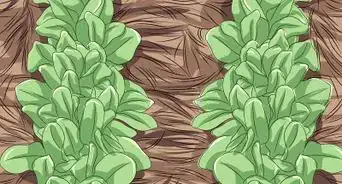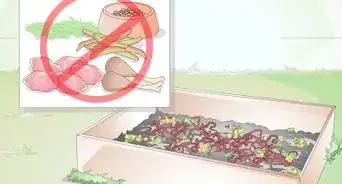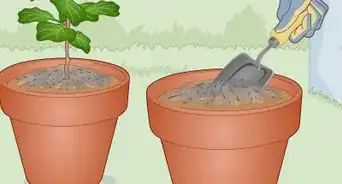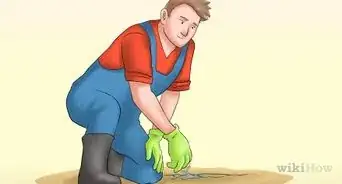This article was co-authored by Ben Barkan. Ben Barkan is a Garden and Landscape Designer and the Owner and Founder of HomeHarvest LLC, an edible landscapes and construction business based in Boston, Massachusetts. Ben has over 12 years of experience working with organic gardening and specializes in designing and building beautiful landscapes with custom construction and creative plant integration. He is a Certified Permaculture Designer, is licensed Construction Supervisor in Massachusetts, and is a Licensed Home Improvement Contractor. He holds an associates degree in Sustainable Agriculture from the University of Massachusetts Amherst.
There are 16 references cited in this article, which can be found at the bottom of the page.
wikiHow marks an article as reader-approved once it receives enough positive feedback. This article received 25 testimonials and 100% of readers who voted found it helpful, earning it our reader-approved status.
This article has been viewed 491,921 times.
Sick of throwing out cup after cup of grounds after your morning caffeine fixes? With their high nutrient content, coffee grounds can be used to make your garden thrive. They are naturally close to a neutral pH[1] and high in nutrients plants need like nitrogen and potassium, which can be very beneficial – a great way to enrich nutrient-poor gardens.[2] With a little creativity, coffee grounds can be used to help in a variety of other garden tasks as well.
Steps
Using Grounds as a Soil Supplement
-
1Add coffee grounds to your compost.[3] One of the simplest ways to use leftover grounds is to add them to the rest of your compost. In addition to providing extra organic matter, coffee grounds are able to speed up the decomposing process in compost. Getting this benefit is as easy as pouring the leftover grounds into the compost pile and mixing to incorporate them.
- Quantities up to 1/4 and 1/3rd of the compost pile have been recommended.[4]
- There are two main types of composting materials: "green" compost and "brown" compost. Coffee grounds are considered to be "green" compost along with other wet, nutrient rich materials. If you add a lot of coffee grounds to your compost, balance it out by adding some "brown" compost as well — dry, bulky materials like dry leaves, twigs, newspaper, straw, corn husks, sawdust, and so on.[5]
- Due to phytotoxins in the used coffee grounds, compost made with used coffee grounds may take 6 months to a year to mature and break down the phytotoxins.[6]
-
2Use coffee grounds to add nutrients to your soil.[7] They are rich in several nutrients that are critical to healthy plants, so if your garden lacks these, coffee grounds are an excellent choice. See below:[8]
- Coffee grounds are rich in:
- Nitrogen
- Magnesium
- Potassium
- Coffee grounds are not rich in:
- Phosphorous
- Calcium
Advertisement -
3Optionally, make a liquid plant food. You don't need to use the coffee grounds themselves in your garden — you can also make a nutritious plant food from them and use it instead. To do this, place a handful of coffee grounds into a bucket of water. Let it sit in a cool, out-of-the-way place (like your garage) for a day or two. It should create a nice amber-colored liquid. Strain the remaining grounds out, then use the liquid to water your plants.
- It will have the same nutrient content as normal coffee grounds, so use it with caution if your plants don't require nitrogen, potassium, etc.
Using Grounds for Alternate Tasks
-
1Use grounds to deter pests. Slugs and snails can chew up your most prized plants, but they are not fond of coffee grounds. Sprinkle a handful of grounds around the bases of plants you want to protect. If you're worried about phytotoxic effects on the soil, make a solid ring of grounds farther away from the base.
- It's thought that this works because the caffeine in the coffee grounds hurts these pests.[9]
-
2Use grounds to keep cats out of your garden. Coffee grounds aren't just good for tiny pests. They can also be used to keep feline friends from playing in your delicate plants. In this case, use the grounds just as you'd use them to repel snails — sprinkle them around the plants you want to protect. The phytotoxic effect on the soil may be unavoidable here due to how much you'll need to use.
-
3Use coffee grounds as worm food, with caution. If you participate in vermiculture (raising worms), you have a great opportunity to use up your coffee grounds. Worms love to eat coffee grounds, so feel free to add plenty to your worm bin or a worm-containing compost pile. Note, however, that coffee grounds should be part of a balanced diet: fruit and vegetable scraps, newspaper, leaves, and so on should accompany any coffee grounds you add.[10] A diet of straight coffee grounds has been shown to kill earthworms.[11]
-
4Use grounds to discourage fungal infection. There is some evidence that coffee grounds can be used to prevent certain types of fungus from attacking your plants. A light sprinkling of coffee grounds may be able to prevent Fusarium, Pythium, and Sclerotinia species of fungi from taking root. Tomatoes, eggplants, and peppers are especially vulnerable to fungal infections, so coffee grounds make an especially good choice for these plants.[12]
Expert Q&A
Did you know you can get expert answers for this article?
Unlock expert answers by supporting wikiHow
-
QuestionCan I use coffee grounds in my vegetable garden?
 Lauren KurtzLauren Kurtz is a Naturalist and Horticultural Specialist. Lauren has worked for Aurora, Colorado managing the Water-Wise Garden at Aurora Municipal Center for the Water Conservation Department. She earned a BA in Environmental and Sustainability Studies from Western Michigan University in 2014.
Lauren KurtzLauren Kurtz is a Naturalist and Horticultural Specialist. Lauren has worked for Aurora, Colorado managing the Water-Wise Garden at Aurora Municipal Center for the Water Conservation Department. She earned a BA in Environmental and Sustainability Studies from Western Michigan University in 2014.
Professional Gardener
-
QuestionDo coffee grounds make good fertilizer?
 Lauren KurtzLauren Kurtz is a Naturalist and Horticultural Specialist. Lauren has worked for Aurora, Colorado managing the Water-Wise Garden at Aurora Municipal Center for the Water Conservation Department. She earned a BA in Environmental and Sustainability Studies from Western Michigan University in 2014.
Lauren KurtzLauren Kurtz is a Naturalist and Horticultural Specialist. Lauren has worked for Aurora, Colorado managing the Water-Wise Garden at Aurora Municipal Center for the Water Conservation Department. She earned a BA in Environmental and Sustainability Studies from Western Michigan University in 2014.
Professional Gardener
-
QuestionWhich plants like coffee grounds?
 Ben BarkanBen Barkan is a Garden and Landscape Designer and the Owner and Founder of HomeHarvest LLC, an edible landscapes and construction business based in Boston, Massachusetts. Ben has over 12 years of experience working with organic gardening and specializes in designing and building beautiful landscapes with custom construction and creative plant integration. He is a Certified Permaculture Designer, is licensed Construction Supervisor in Massachusetts, and is a Licensed Home Improvement Contractor. He holds an associates degree in Sustainable Agriculture from the University of Massachusetts Amherst.
Ben BarkanBen Barkan is a Garden and Landscape Designer and the Owner and Founder of HomeHarvest LLC, an edible landscapes and construction business based in Boston, Massachusetts. Ben has over 12 years of experience working with organic gardening and specializes in designing and building beautiful landscapes with custom construction and creative plant integration. He is a Certified Permaculture Designer, is licensed Construction Supervisor in Massachusetts, and is a Licensed Home Improvement Contractor. He holds an associates degree in Sustainable Agriculture from the University of Massachusetts Amherst.
Garden & Landscape Designer
Warnings
- If you have a thick layer of coffee grounds that you leave to dry, they will repel water, much like peat moss.[19]⧼thumbs_response⧽
- If you add coffee grounds directly to soil, add a nitrogen fertiliser at the same time,[20] as the process of degrading fresh organic material temporarily reduces the nitrogen available for plants.[21]⧼thumbs_response⧽
- Spent coffee grounds have phytotoxic properties, which can be reduced through composting.[22] Putting spent coffee grounds directly into a soil mixture and then using it to grow plants has been experimentally proved to inhibit the growth of both commonly grown plant species (broccoli, leek, radish, viola and sunflower), and weed species, even when quantities as small as 2.5% are added.[23]⧼thumbs_response⧽
- If you keep your coffee grounds in a closed bucket to reduce their caffeine content through fungal action, make sure you open the bucket in a well-ventilated area and avoid breathing in the spores.⧼thumbs_response⧽
References
- ↑ https://extension.oregonstate.edu/gardening/soil-compost/coffee-grounds-composting
- ↑ Ben Barkan. Garden & Landscape Designer. Expert Interview. 2 June 2020.
- ↑ Ben Barkan. Garden & Landscape Designer. Expert Interview. 2 June 2020.
- ↑ https://extension.oregonstate.edu/gardening/soil-compost/coffee-grounds-composting
- ↑ http://www.gardeningknowhow.com/composting/ingredients/browns-greens-compost.htm#brown
- ↑ https://www.abc.net.au/everyday/the-right-way-to-use-old-coffee-grounds-in-garden/100200830
- ↑ Ben Barkan. Garden & Landscape Designer. Expert Interview. 2 June 2020.
- ↑ http://www.gardensalive.com/product/using-coffee-grounds-correctly/you_bet_your_garden
- ↑ http://www.gardeningknowhow.com/composting/ingredients/coffee-grounds-gardening.htm
- ↑ http://www.nwedible.com/5-ways-to-use-coffee-grounds-in-the-garden/
- ↑ https://doi.org/10.1016/j.biortech.2011.05.073
- ↑ http://www.nwedible.com/5-ways-to-use-coffee-grounds-in-the-garden/
- ↑ https://thescientificgardener.com/can-i-put-coffee-grounds-in-my-compost-pile
- ↑ https://doi.org/10.1007/s11356-018-2359-6
- ↑ https://doi.org/10.1016/j.tifs.2015.04.012
- ↑ https://www.ncbi.nlm.nih.gov/pmc/articles/PMC1276408/
- ↑ https://www.mdpi.com/2571-8797/3/2/19/htm
- ↑ https://ktrh.iheart.com/featured/gardenline-with-randy-lemmon/content/2020-07-06-using-coffee-grounds-as-fertilizer-and-pest-control/
- ↑ https://extension.oregonstate.edu/gardening/soil-compost/coffee-grounds-composting
- ↑ https://extension.oregonstate.edu/gardening/soil-compost/coffee-grounds-composting
- ↑ https://extension.oregonstate.edu/pub/ec-1561
- ↑ https://doi.org/10.1007/s11356-018-2359-6
- ↑ https://doi.org/10.1016/j.ufug.2016.02.015
About This Article
If you’re looking for ways to use coffee grounds in your garden, try mixing them in with your compost. Coffee grounds are considered a green material, and they provide extra organic matter in addition to speeding up the decomposition process. If you have plants that prefer acidic soil, like blueberries, camellias, and gardenias, sprinkle the coffee grounds near the roots of the plants at the start of the growing season to raise the soil’s acidity. To learn tips from our horticulture reviewer on how to use coffee grounds to keep slugs and snails away from your plants, read on!


